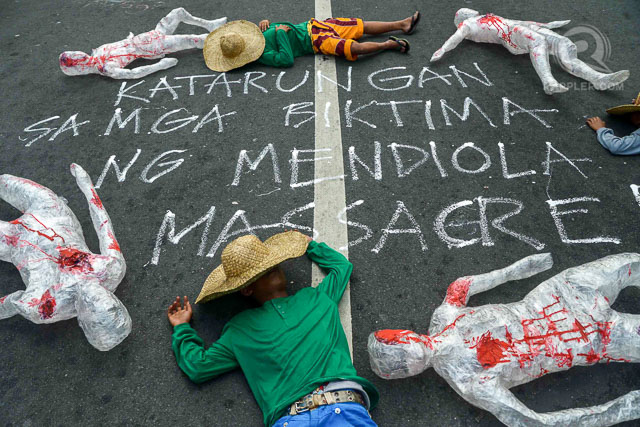
MANILA, Philippines – On January 22, 1987, an otherwise peaceful mobilization on Mendiola Street turned into a bloody dispersal that took the lives of 13 farmers.
The unfortunate incident came to be known as the Mendiola Massacre.
Thousands of farmers and peasants marched toward Malacañang, hoping for a dialogue with President Corazon C. Aquino, but were met by government forces, instead. In the midst of a scuffle, the latter opened fired on 10,000 to 15,000 farm workers and peasants demanding equal land distribution and decent wages.
Here’s what you need to know about the Mendiola Massacre:
1. How it happened
Led by Kilusang Magbubukid sa Pilipinas (KMP) and its national president, Jaime Tadeo, the farmers began their encampment at what was then the Ministry of Agrarian Reform on January 15, 1987.
On January 20, then agrarian reform minister Heherson Alvarez met with Tadeo and promised to raise their problems and demands to the President at their scheduled Cabinet meeting on January 21.
On January 21, tension mounted as protesters barricaded the DAR premises, preventing employees from entering the building.
On January 22, the group decided to bring their demands to Malacañang, where they hoped to have a dialogue with Aquino. This was captured in the newsreel produced by Asia Visions, an alternative audio-visual institution during the 1980s, and uploaded by PinoyWeekly.
The video shows scenes from the mobilization as the group marched from Liwasang Bonifacio to Mendiola.
At around 4:30 pm, the protesters headed to the police line and began pushing against the barricade. The marchers and the anti-riot squad did not have any dialogue. It was during this time when violence erupted.
The Citizens’ Mendiola Commission said in its investigation:
“There was an explosion followed by throwing of pillboxes, stones and bottles. Steel bars, wooden clubs and lead pipes were used against the police. The police fought back with their shields and truncheons. The police line was breached. Suddenly shots were heard. The demonstrators disengaged from the government forces and retreated towards C.M. Recto Avenue. But sporadic firing continued from the government forces.”
2. Injustice
Following the massacre, Aquino created the Citizens’ Mendiola Commission to facilitate the filing of criminal charges against all those responsible for the violent dispersal. The House Committee on Human Rights also recommended compensation for the victims.
No one was punished for the death of the farmers. Survivors and relatives of the victims did not receive any compensation.
A year after the incident, the Manila Regional Trial Court dismissed the class suit filed by the families of the victims and survivors against the government, and police and military officials. The Supreme Court upheld the ruling in March 1993, citing the government's immunity from suit.
Among the respondents and the positions they held at the time of the incident where then defense secretary Fidel Ramos, former Western Police District superintendent Alfredo Lim, then Armed Forces chief General Renato de Villa, former Philippine Marines chief Rodolfo Biazon, and Brigadier General Brigido Paredes, former Marines commandant.
3. Fight for land reform and decent wages
The farmers and peasant workers launched the 8-day mobilization to call for equal agrarian justice and decent wages – appeals that were seen as especially meaningful at that juncture. Those who were failed by the promises of ousted strongman Ferdinand Marcos thought they finally had the opportunity to air their grievances.
During the mobilization, the farmers' group presented their proposal for genuine agrarian reform:
- Give land for free to farmers
- Zero retention of lands by landlords
- Stop amortization
Up to the present, the fight of the farmers for genuine land reform continues. Farmers are still pushing for the immediate passage of the Genuine Agrarian Reform Bill (GARB) or House Bill No. 3059 which seeks the distribution of land to farmers for free.
4. Current DAR chief is a Mendiola Massacre survivor
Will the fight for genuine agrarian reform succeed under the Duterte administration? For farmers familiar with the decades-long struggle, there is enough reason to hope.
Agrarian Reform Secretary Rafael “Ka Paeng” V. Mariano is one of the many farmers who were at the Mendiola protest 30 years ago. A Mendiola Massacre survivor himself, Mariano has pledged to uphold the struggle for genuine agrarian reform.
Before entering public office, Mariano served as KMP secretary-general of the organization when it was founded in 1985. He served as KMP president in 1993, just a few years after the Mendiola Massacre. – Rappler.com